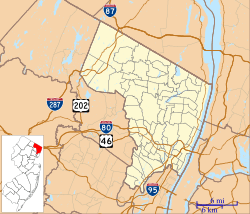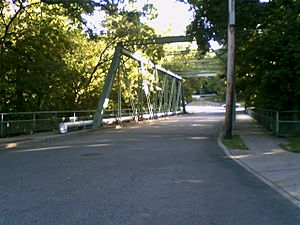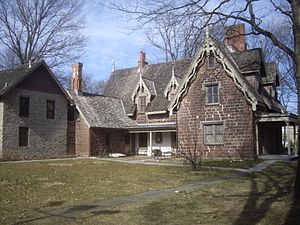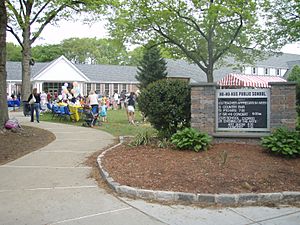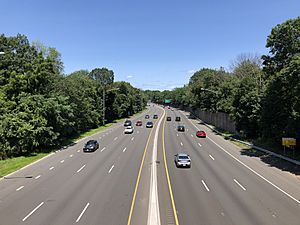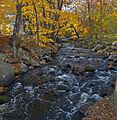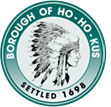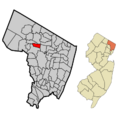Ho-Ho-Kus, New Jersey facts for kids
Ho-Ho-Kus (pronounced ho-HO-kus) is a small town, called a borough, located in Bergen County, New Jersey. It's known for being a beautiful and wealthy community with a low crime rate and excellent schools. Many people choose to live here because it's also close to New York City.
As of the 2020 census, about 4,258 people live in Ho-Ho-Kus. The town is home to important historical places like the Ho-Ho-Kus Inn and The Hermitage.
Ho-Ho-Kus became an official borough on October 12, 1908. Before that, it was known as the borough of Orvil, which was created in 1905 from parts of Orvil Township.
In 2011, New Jersey Monthly magazine even called Ho-Ho-Kus the best place to live in New Jersey!
Quick facts for kids
Ho-Ho-Kus, New Jersey
|
||
|---|---|---|
|
Borough
|
||
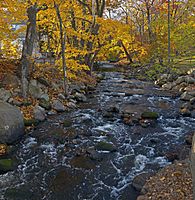
The Ho-Ho-Kus Brook flowing through downtown Ho-Ho-Kus
|
||
|
||
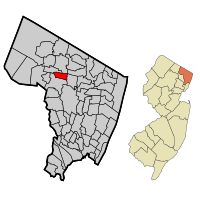
Location of Ho-Ho-Kus in Bergen County highlighted in red (left). Inset map: Location of Bergen County in New Jersey highlighted in orange (right).
|
||
| Country | ||
| State | ||
| County | Bergen | |
| Incorporated | March 8, 1905 (as Orvil) | |
| Reincorporated | October 12, 1908 (as Ho-Ho-Kus) | |
| Government | ||
| • Type | Borough | |
| • Body | Borough Council | |
| Area | ||
| • Total | 1.75 sq mi (4.53 km2) | |
| • Land | 1.74 sq mi (4.51 km2) | |
| • Water | 0.01 sq mi (0.03 km2) 0.63% | |
| Area rank | 425th of 565 in state 53rd of 70 in county |
|
| Elevation | 121 ft (37 m) | |
| Population
(2020)
|
||
| • Total | 4,258 | |
| • Estimate
(2023)
|
4,232 | |
| • Rank | 407th of 565 in state 63rd of 70 in county |
|
| • Density | 2,447.9/sq mi (945.1/km2) | |
| • Density rank | 256th of 565 in state 52nd of 70 in county |
|
| Demonym(s) | Ho-Ho-Kusite | |
| Time zone | UTC−05:00 (Eastern (EST)) | |
| • Summer (DST) | UTC−04:00 (Eastern (EDT)) | |
| ZIP Code |
07423
|
|
| Area code(s) | 201 | |
| FIPS code | 3400332310 | |
| GNIS feature ID | 0885258 | |
| Website | ||
Contents
What's in a Name? The History of Ho-Ho-Kus
The name "Ho-Ho-Kus" has a mysterious past, and people have debated its meaning for a long time. The most likely explanation comes from the Delaware Indian language. It might be a shorter version of "Mah-Ho-Ho-Kus" or "Mehokhokus," which means "the red cedar."
Other ideas for the name's origin include:
- A Lenape word for "running water."
- Meaning "a cleft in the rock," "under the rock," or "hollow rock."
- The word "hohokes," which describes the sound of wind whistling through tree bark.
- It could be linked to the Chihohokies Indians, whose chief once lived here.
- Some think it comes from the Dutch words Hoog Akers ("high acorns") or Hoge Aukers ("high oaks").
- Another theory suggests it's from the Lenape word hoccus ("fox") or woakus ("gray fox").
- Finally, some believe the "Ho" part means joy or spirit, and the rest comes from "hohokes," referring to a type of tree bark.
Ho-Ho-Kus vs. Hohokus: Why the Hyphens?
It can be confusing because there's also a place called Hohokus Township (now known as Mahwah), which doesn't have hyphens or capital letters in each part of its name. This township used to cover the area where Ho-Ho-Kus and other nearby towns are now.
When the town officially changed its name on October 12, 1908, the leaders specifically asked for it to be called "Ho-Ho-Kus" with hyphens and capital letters.
There are a couple of reasons why they might have chosen this unique spelling:
- It helped tell the difference between the new borough and the older Hohokus Township.
- It might have been to prevent mail from getting mixed up with mail going to Hoboken.
Even though there have been attempts to change the name or its spelling over the years, the borough is still officially known as "Ho-Ho-Kus."
Where is Ho-Ho-Kus?
Ho-Ho-Kus covers about 1.75 square miles (4.53 square kilometers). Most of this area is land, with a very small amount of water.
The borough shares its borders with several other towns in New Jersey:
- Hillsdale
- Ridgewood
- Saddle River
- Waldwick
- Washington Township
People and Community
| Historical population | |||
|---|---|---|---|
| Census | Pop. | %± | |
| 1900 | 316 | — | |
| 1910 | 488 | 54.4% | |
| 1920 | 586 | 20.1% | |
| 1930 | 925 | 57.8% | |
| 1940 | 1,626 | 75.8% | |
| 1950 | 2,254 | 38.6% | |
| 1960 | 3,988 | 76.9% | |
| 1970 | 4,348 | 9.0% | |
| 1980 | 4,129 | −5.0% | |
| 1990 | 3,935 | −4.7% | |
| 2000 | 4,060 | 3.2% | |
| 2010 | 4,078 | 0.4% | |
| 2020 | 4,258 | 4.4% | |
| 2023 (est.) | 4,232 | 3.8% | |
| Population sources: 1910–1920 1910 1910–1930 1900–2020 2000 2010 2020 |
|||
In 2010, there were 4,078 people living in Ho-Ho-Kus. Most residents were White (92.03%), with a smaller percentage of Asian (5.79%) and Hispanic or Latino (4.12%) residents. About 29.3% of the population was under 18 years old.
Ho-Ho-Kus is known for being a wealthy community. In 2010, the average home price was around $901,841. This is because many families in Ho-Ho-Kus have high incomes. For example, the average household income in 2010 was about $155,030.
Places to Visit

Ho-Ho-Kus has a couple of interesting historical spots:
- The Hermitage: This historic house is famous because Aaron Burr, who was once the Vice President of the United States, got married here and lived there for a short time. It's listed on the National Register of Historic Places.
- The Ho-Ho-Kus Inn: Also known as the Ho-Ho-Kus Inn & Tavern, this is another historic building that now operates as a restaurant.
Education in Ho-Ho-Kus
The Ho-Ho-Kus School District serves students from pre-kindergarten through eighth grade at Ho-Ho-Kus Public School. In the 2020–21 school year, there were about 597 students and 49.7 teachers, meaning there were about 12 students for every teacher.
After eighth grade, students from Ho-Ho-Kus attend Northern Highlands Regional High School in nearby Allendale. This high school also serves students from Allendale, Upper Saddle River, and parts of Saddle River. In 2020–21, the high school had 1,364 students. New Jersey Monthly magazine has ranked Northern Highlands Regional High School as one of the best high schools in New Jersey.
For many years, Ho-Ho-Kus students went to Midland Park High School. However, because that school was small and didn't offer many choices for classes, Ho-Ho-Kus decided to send its students to Northern Highlands Regional High School starting in the 1990s. This agreement is set to continue until at least 2026.
Students in Bergen County, including those from Ho-Ho-Kus, can also apply to special high school programs offered by the Bergen County Technical Schools. These include the Bergen County Academies in Hackensack and the Bergen Tech campuses in Teterboro or Paramus. These schools offer unique programs, and students are chosen through an application process.
Ho-Ho-Kus is also home to the Ho-Ho-Kus Waldwick Cooperative Nursery School for younger children.
Getting Around Ho-Ho-Kus
Ho-Ho-Kus has about 26.52 miles of roads. Most of these roads are maintained by the town itself, while some are managed by Bergen County or the state of New Jersey.
Major roads that go through Ho-Ho-Kus include:
- Route 17
- County Route 507
- County Route 502
You can also reach Ho-Ho-Kus from Garden State Parkway exit 168, which is in the neighboring town of Washington Township.
Public Transportation
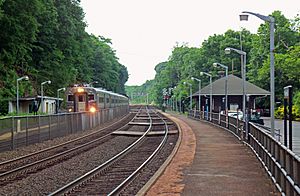
Ho-Ho-Kus has its own train station, the Ho-Ho-Kus NJ Transit station. This station serves both the Bergen County Line and the Main Line. These train lines travel north and south, connecting to Hoboken Terminal. From Hoboken, you can transfer to other trains to reach places like New York Penn Station in New York City. You can also connect to the PATH train, ferries, and light rail services from Hoboken.
There are also bus services provided by Short Line that connect Ho-Ho-Kus to the Port Authority Bus Terminal in Midtown Manhattan.
Famous People from Ho-Ho-Kus
Many notable people have lived in or are connected to Ho-Ho-Kus:
- Aaron Burr (1756–1836): The third Vice President of the United States, who married and briefly lived at The Hermitage.
- Richard Chilton (born 1958): A successful businessman, investor, and giver to charity.
- David Duffield (born 1940): A businessman who founded several important software companies like PeopleSoft and Workday.
- Jim Fassel (1949–2021): A former head coach for the New York Giants football team.
- Andrew McMahon (born 1982): A musician and singer-songwriter known for being the lead singer of bands like Jack's Mannequin.
- Dan Reeves (1944–2022): A former football player for the Dallas Cowboys and a former head coach for the New York Giants.
- Chloe Troast (born 1997): A comedian and actress who joined the cast of the TV show Saturday Night Live in 2023.
- Metta Victoria Fuller Victor (1831–1885): A novelist who wrote many "dime novels" and is known for writing one of the first American detective novels.
- Orville James Victor (1827–1910): A writer and editor who is considered the creator of the "dime novel."
- Luke Wypler (born 2001): An American football player who plays as a center for the Cleveland Browns.
Images for kids
-
The Ho-Ho-Kus Brook flowing through downtown Ho-Ho-Kus
-
Location of Ho-Ho-Kus in Bergen County highlighted in red (left). Inset map: Location of Bergen County in New Jersey highlighted in orange (right).
See also
 In Spanish: Ho-Ho-Kus para niños
In Spanish: Ho-Ho-Kus para niños



